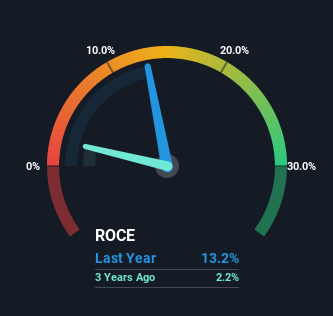- Canada
- /
- Renewable Energy
- /
- TSXV:JPWR.H
Jade Power Trust's (CVE:JPWR.UN) Returns On Capital Are Heading Higher
Finding a business that has the potential to grow substantially is not easy, but it is possible if we look at a few key financial metrics. Ideally, a business will show two trends; firstly a growing return on capital employed (ROCE) and secondly, an increasing amount of capital employed. If you see this, it typically means it's a company with a great business model and plenty of profitable reinvestment opportunities. So when we looked at Jade Power Trust (CVE:JPWR.UN) and its trend of ROCE, we really liked what we saw.
Understanding Return On Capital Employed (ROCE)
For those who don't know, ROCE is a measure of a company's yearly pre-tax profit (its return), relative to the capital employed in the business. Analysts use this formula to calculate it for Jade Power Trust:
Return on Capital Employed = Earnings Before Interest and Tax (EBIT) ÷ (Total Assets - Current Liabilities)
0.13 = CA$7.8m ÷ (CA$69m - CA$9.5m) (Based on the trailing twelve months to March 2022).
Thus, Jade Power Trust has an ROCE of 13%. On its own, that's a standard return, however it's much better than the 4.5% generated by the Renewable Energy industry.
View our latest analysis for Jade Power Trust

While the past is not representative of the future, it can be helpful to know how a company has performed historically, which is why we have this chart above. If you're interested in investigating Jade Power Trust's past further, check out this free graph of past earnings, revenue and cash flow.
So How Is Jade Power Trust's ROCE Trending?
The trends we've noticed at Jade Power Trust are quite reassuring. The data shows that returns on capital have increased substantially over the last five years to 13%. The amount of capital employed has increased too, by 47%. This can indicate that there's plenty of opportunities to invest capital internally and at ever higher rates, a combination that's common among multi-baggers.
One more thing to note, Jade Power Trust has decreased current liabilities to 14% of total assets over this period, which effectively reduces the amount of funding from suppliers or short-term creditors. This tells us that Jade Power Trust has grown its returns without a reliance on increasing their current liabilities, which we're very happy with.
What We Can Learn From Jade Power Trust's ROCE
A company that is growing its returns on capital and can consistently reinvest in itself is a highly sought after trait, and that's what Jade Power Trust has. Astute investors may have an opportunity here because the stock has declined 56% in the last five years. So researching this company further and determining whether or not these trends will continue seems justified.
Jade Power Trust does have some risks though, and we've spotted 2 warning signs for Jade Power Trust that you might be interested in.
For those who like to invest in solid companies, check out this free list of companies with solid balance sheets and high returns on equity.
The New Payments ETF Is Live on NASDAQ:
Money is moving to real-time rails, and a newly listed ETF now gives investors direct exposure. Fast settlement. Institutional custody. Simple access.
Explore how this launch could reshape portfolios
Sponsored ContentNew: Manage All Your Stock Portfolios in One Place
We've created the ultimate portfolio companion for stock investors, and it's free.
• Connect an unlimited number of Portfolios and see your total in one currency
• Be alerted to new Warning Signs or Risks via email or mobile
• Track the Fair Value of your stocks
Have feedback on this article? Concerned about the content? Get in touch with us directly. Alternatively, email editorial-team (at) simplywallst.com.
This article by Simply Wall St is general in nature. We provide commentary based on historical data and analyst forecasts only using an unbiased methodology and our articles are not intended to be financial advice. It does not constitute a recommendation to buy or sell any stock, and does not take account of your objectives, or your financial situation. We aim to bring you long-term focused analysis driven by fundamental data. Note that our analysis may not factor in the latest price-sensitive company announcements or qualitative material. Simply Wall St has no position in any stocks mentioned.
About TSXV:JPWR.H
Flawless balance sheet with solid track record.
Market Insights
Weekly Picks

THE KINGDOM OF BROWN GOODS: WHY MGPI IS BEING CRUSHED BY INVENTORY & PRIMED FOR RESURRECTION


Why Vertical Aerospace (NYSE: EVTL) is Worth Possibly Over 13x its Current Price


The Quiet Giant That Became AI’s Power Grid
Recently Updated Narratives


MINISO's fair value is projected at 26.69 with an anticipated PE ratio shift of 20x


Fiverr International will transform the freelance industry with AI-powered growth

Stride Stock: Online Education Finds Its Second Act
Popular Narratives


MicroVision will explode future revenue by 380.37% with a vision towards success


Crazy Undervalued 42 Baggers Silver Play (Active & Running Mine)




